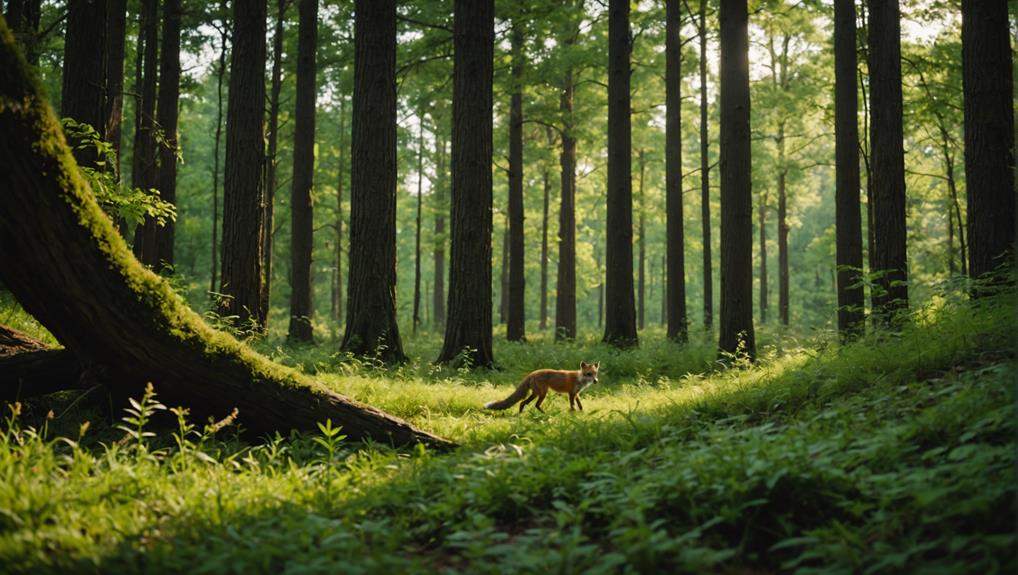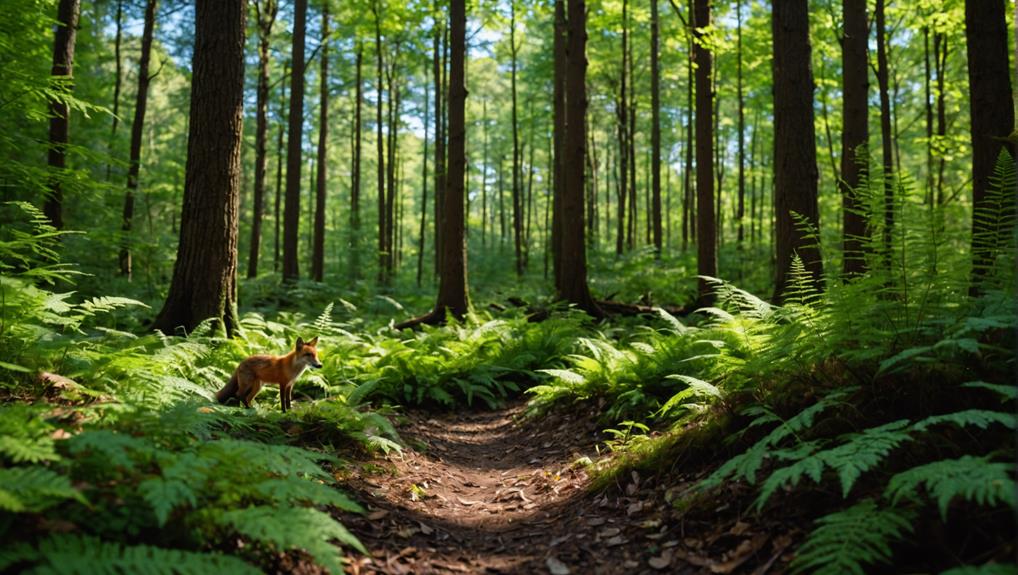Finding fox dens and habitats can be a fun adventure! Start by looking in loamy soil or compact sand, since swift foxes love to dig there. Keep your eyes peeled for keyhole-shaped entrance holes—around a foot wide—and well-worn trails that hint at frequent visits. Watch for signs of life, like fresh tracks or scat, especially near prairie dog colonies. Remember, foxes are most active at dawn and dusk, so grab your binoculars then. Each season changes their patterns, too. Stick around, and you might just spot some clever fox antics in action! Want to learn more? There's plenty to uncover!
Contents
Understanding Habitat Preferences
When you explore swift fox habitats, you'll notice they've specific preferences that guide their choices. These clever little creatures thrive on loamy soil or compact sand, steering clear of thick grass and dense vegetation, which can be like a maze for them.
Imagine trying to dance in a crowded room; not easy, right? Red foxes, similarly, prefer environments that offer a mix of cover and open space, such as forests and grasslands, providing them ample hunting grounds and shelter.
Swift foxes are savvy when it comes to their den sites. They often set up shop near prairie dog or ground squirrel colonies, taking advantage of those burrowing buddies' abandoned tunnels for shelter.
Their dens typically have circular or keyhole entrances, about 7-9 inches wide, giving you a peek into their world.
Within their home range of 0.5 to 1 square mile, swift foxes maintain several dens, making sure they've safe spots close to reliable food sources.
Seasonal shifts and habitat conditions play a big role in how they use these dens, showcasing their adaptability. So, if you're looking to help these adorable foxes, understanding their habitat preferences is key. You'll not only help them thrive but also enrich your experience in the great outdoors!
Identifying Den Features
When you're on the hunt for fox dens, keep an eye out for those unique entrance features.
Red foxes often establish their dens in well-drained areas, utilizing natural features to create their cozy homes. You might spot a fresh dirt mound with a hole about a foot wide, or even a keyhole shape that's just the right size for a curious fox.
Plus, well-worn trails leading to the den can give you a good clue that you're in the right spot—it's like finding the secret pathway to their cozy little home!
urban environments can provide ideal conditions for these furry residents.
Den Entrance Characteristics
The charm of locating a fox den lies in its distinctive entrance characteristics, which reveal much about the resident's habits. When you're out on your search, look for a small entrance hole, usually around 7-9 inches in diameter. This tiny portal leads to an intricate network of tunnels—think of it as their secret underground world!
You'll often find the area around the den freshly disturbed, with dirt mounds signaling recent activity. Red foxes are known for their adaptability, allowing them to thrive in various environments, which can influence where they choose to establish their dens, particularly in urban and rural settings.
The main den entrance is typically well-worn, showing signs of frequent fox movement. Don't forget to check for secondary entrances, which might've less noticeable trails. Remember, foxes are sneaky little creatures!
You'll want to look for well-drained gravelly soil, especially on steep banks. This gives the den safety and stability. Keep your eyes peeled for animal remains or scat near the entrance; these are great indicators of a fox's presence and their predatory habits.
It's like finding clues in a mystery novel! By paying attention to these den entrance characteristics, you'll be well on your way to uncovering the fascinating lives of these clever animals. Happy den hunting!
Surrounding Habitat Indicators
Numerous habitat indicators can help you identify potential fox dens and their features. Start by looking for fresh dirt mounds and holes about one foot in diameter. These might be entrance tunnels leading to cozy fox homes.
You'll also want to keep an eye out for well-traveled trails. These paths indicate regular activity, meaning those foxes are likely nearby.
Foxes have a preference for den locations near small clearings or open areas. They enjoy high visibility for safety and hunting purposes.
As you explore, look for signs like animal remains or scat, which can tell you that the den is occupied and the foxes are actively hunting.
Don't forget to check for multiple entrances, which are common for fox dens. You might find circular or keyhole-shaped openings that are 7-9 inches wide.
Each of these signs brings you closer to discovering a fox den. So, grab your binoculars and enjoy the adventure; you never know what you'll find in the wild!
Happy den hunting, and remember to respect their space while you observe!
Assessing Environmental Impacts

As foxes establish their dens, they create a ripple effect on the surrounding environment that can't be overlooked.
These clever creatures not only find shelter but also enhance soil fertility through their organic waste, which can improve the soil pH levels. This means healthier plants can thrive nearby, which contributes to greater biodiversity. In fact, studies show that areas around fox dens often boast more plant species than undisturbed spots!
But it doesn't stop there! The presence of foxes can even influence local prey populations. They adapt their resting sites depending on what's available to eat, showcasing their impressive ability to adjust to changing habitat characteristics.
However, don't forget the impact of urbanization. As our cities expand, understanding how this affects fox behavior and their ecological interactions becomes increasingly essential.
Observing Fox Behavior
When you're out in the wild, keep an eye on the skies as dusk and dawn roll in—these are prime times to catch swift foxes in action.
You might spot them hunting or foraging, and trust me, it's a sight that makes you feel like you've just stumbled onto a little secret of nature.
Plus, if you notice some fresh tracks or signs of feeding near their dens, you're in for a real treat as you learn more about their clever ways of surviving!
Nocturnal Activity Patterns
Observing swift foxes during their nocturnal activity can be a thrilling experience, especially if you time your outings around dusk or dawn.
These little furballs are primarily nocturnal, meaning they're most active when the sun dips below the horizon. If you're lucky, you might catch a glimpse of their unique hunting strategies as they dash through open areas, reaching speeds of 30 to 40 mph.
To increase your chances of spotting these swift foxes, scout areas with open vistas where they can see and move easily. Keep an eye on potential den sites, as these will often be hotspots for their activity.
Seasonal changes can also affect their behavior, especially when they're busy feeding their pups in late spring and summer.
Want to enhance your observation efforts? Consider using game cameras near those dens. You'll be amazed at the evidence you can capture of their nighttime escapades!
Just remember, patience is key. So grab your binoculars, head out at the right times, and enjoy the show. You're not just observing; you're connecting with nature and its fascinating creatures!
Foraging and Hunting Behavior
Swift foxes showcase remarkable foraging and hunting behaviors that reflect their adaptability and keen instincts. You'll find these agile little creatures primarily hunting rodents like prairie dogs and voles, using their impressive speed of 30-40 mph to catch their food. Their hunting behavior is a charming mix of skill and strategy, as they often scavenge for various snacks, too!
To better understand their foraging habits, keep an eye out for these key behaviors:
- Opportunistic Feeders: They enjoy a diverse diet, including birds, rabbits, lizards, and even berries.
- Nocturnal Activity: During late spring and summer, swift foxes are more active, especially when they need to feed their pups.
- Best Observation Times: Early morning and late evening are prime times to spot their foraging antics.
Watching swift foxes can be a delightful experience. Their sharp hearing helps them locate prey hidden in dense grass, making them fascinating hunters.
Recognizing Seasonal Changes

Understanding seasonal changes is essential for effectively locating fox dens and habitats.
When temperatures rise in late spring and summer, foxes living in your area may become more active during the day, especially when they're feeding their pups. This increase in activity gives you a better chance of spotting signs of dens and tracks.
During winter, don't underestimate the power of snow! Fresh tracks can lead you right to active sites, revealing recent denning activity. Keep an eye on prey availability, too. Seasonal changes can influence foraging behavior, prompting foxes to set up dens closer to food sources like prairie dog colonies.
In autumn, you might notice foxes ramping up their denning activities as they prepare for the colder months. This is a prime time for observing foxes as they settle into their cozy homes.
To truly understand where these clever critters are hanging out, make repeated visits to potential den sites throughout different seasons. You'll be amazed at how their habits shift with the changing weather.
Your efforts in recognizing these seasonal changes won't only deepen your connection with nature but also allow you to help others appreciate the wonders of fox life!
Mapping Geographical Habitats
Recognizing seasonal changes not only helps you spot fox activity but also guides you in mapping their geographical habitats.
To find swift fox dens, you should focus on areas with loamy soil or compact sand. These foxes love to dig, especially near prairie dog or ground squirrel colonies, which provide both food and ideal burrowing conditions.
When mapping their habitats, keep an eye out for these key indicators:
- Den Entrances: Look for circular or keyhole-shaped entrances, usually 7-9 inches wide.
- Tracks and Scat: Fresh digging, paw prints, or fecal matter near den sites indicate current occupancy.
- Territory Size: Remember that swift foxes maintain territories of 0.5 to 1 square mile, often with multiple den sites for safety and daily activities.
Supporting Fox Conservation

Supporting swift fox conservation is vital for maintaining healthy ecosystems, especially in areas where their habitats are threatened.
These charming little critters thrive in loamy soil near prairie dog colonies, which are super important for their denning and foraging. By protecting these habitats, we can help guarantee their populations stay strong.
You can play a big role in this by joining community awareness programs. Educating others about the benefits of swift foxes—like their knack for pest control and seed dispersal—can create a positive buzz around conservation.
Plus, teaming up with wildlife organizations to monitor swift fox populations through surveys and game cameras gives us the data we need for effective conservation planning.
Don't forget to advocate for preserving open vistas and low cover areas, as these spaces are vital for swift foxes to hunt and den. Supporting policies that reduce habitat destruction and promote biodiversity can make a real difference, not just in rural areas but also in urban landscapes.
Final Thoughts
Finding fox dens and habitats can feel like starting a treasure hunt in nature's backyard. By understanding their preferences and behaviors, you'll not only uncover where they live but also appreciate the beauty of these clever creatures. Just like a cozy blanket on a chilly night, supporting fox conservation wraps our world in warmth and care. So, grab your gear, step outside, and let your curiosity lead the way—there's a whole adventure waiting for you!














